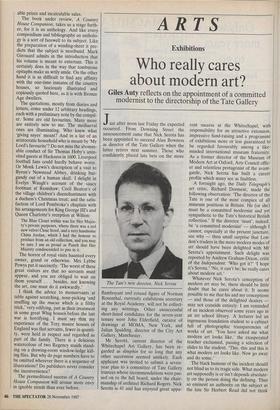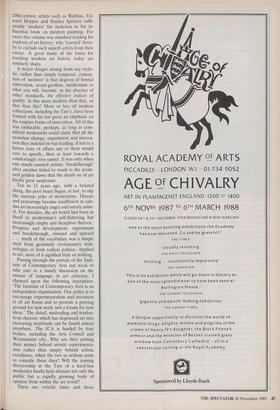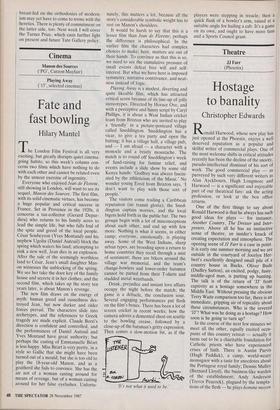ARTS
Exhibitions
Who really cares about modern art?
Just after noon last Friday the expected occurred. From Downing Street the announcement came that Nick Serota has been appointed to succeed Alan Bowness as director of the Tate Gallery when the latter retires next summer. Those who confidently placed late bets on the more
The Tate's new director, Nick Serota flamboyant and rotund figure of Norman Rosenthal, currently exhibitions secretary at the Royal Academy, will not be collect- ing any winnings. Other unsuccessful short-listed candidates for the seven-year tenure were John Elderfield, curator of drawings at MOMA, New York, and Julian Spalding, director of the City Art Gallery, Manchester.
Mr Serota, current director of the Whitechapel Art Gallery, has been re- garded as dauphin for so long that any other succession seemed unlikely. Each applicant was invited to submit a seven- year plan to a committee of Tate Gallery trustees whose recommendations were pas- sed on to the full board, under the chair- manship of architect Richard Rogers. Nick Serota is 41 and has enjoyed great appa- rent success at the Whitechapel, with responsibility for an attractive extension, impressive fund-raising and a programme of exhibitions more or less guaranteed to be regarded favourably among a like- minded international museum fraternity. As a former director of the Museum of Modem Art at Oxford, Arts Council offic- er and relentless protagonist of the avant- garde, Nick Serota has built a career profile which many see as faultless.
A fortnight ago, the Daily Telegraph's art critic, Richard Dorment, made the following observation: 'The director of the Tate is one of the most complex of all museum positions in Britain. He (or she) must be a committed modernist and yet sympathetic to the Tate's historical British collection.' If the director 'must', indeed, be 'a committed modernist' — although cannot, especially at the present juncture, see why — then small surprise that Lon- don's traders in the more modern modes of art should have been delighted with Mr Serota's appointment. Such delight was reported by Andrew Graham-Dixon, critic of the Independent: 'Who got it?' I hope it's Serota."No, it can't be; he really cares about modern art.'
Whatever Nick Serota's conception of modem art may be, there should be little doubt that he cares about it. It seems possible to me that his and my conceptions — and those of the delighted dealers — may not coincide entirely. I am reminded of an incident observed some years ago in an art school library. A lecturer led an ingenuous foundation student to a cabinet full of photographic transparencies of works of art. 'You have asked me what modem art looks like,' the exasperated teacher exclaimed, passing a selection of slides to the student. 'This, this and this is what modem art looks like. Now go away and do some.'
The black humour of the incident should not blind us to its tragic side. What modern art supposedly is or isn't depends absolute- ly on the person doing the defining. Thus so eminent an authority on the subject as the late Sir Herbert Read did not think 20th-century artists such as Balthus, Ed- ward Hopper and Stanley Spencer suffi- ciently 'modern' for inclusion in his in- fluential book on modern painting. For years this volume was standard reading for students of art history, who 'learned' there- by to exclude such superb artists from their essays. A great many of the bases for teaching modern art history today are similarly shaky.
A major danger arising from any stylis- tic, rather than simply temporal, concep- tion of 'modern' is that degrees of formal innovation, avant-gardism, modernism or what you will, become, in the absence of other standards, the effective indices of quality. Is this more modern than that, or that than this? More or less all modern collections, including the Tate's, have been formed with far too great an emphasis on the emptier forms of innovation. All of this was endurable, perhaps, as long as com- mitted modernists could claim that all the ceaseless change, experiment and innova- tion they insisted on was leading, if not to a future state of affairs any of them would care to specify, then at least towards a comfortingly rosy sunset. It was only when one much-vaunted artistic 'breakthrough' after another failed to result in the prom- ised golden dawn that the dumb ox of art finally grew suspicious.
Ten to 15 years ago, with a belated shrug, the poor beast began, at last, to slip the onerous yoke of modernism. Threats and posturings became insufficient to sub- due an increasingly angry and unruly anim- al. For decades, the art world had been in thrall to modernism's self-flattering but increasingly empty and deceptive rhetoric. Progress and development, experiment and breakthrough, onward and upward • . . much of the vocabulary was a simple steal from genuinely evolutionary tech- nologies or from radical politics. Applied to art, most of it signified little or nothing.
Passing through the portals of the Insti- tute of Contemporary Arts last week to take part in a timely discussion on the misuse of language in art criticism, I chanced upon the following inscription: 'The Institute of Contemporary Arts is an independent organisation. Our policy is to encourage experimentation and invention in all art forms and to provide a proving ground for new work and a forum for new ideas.' The dated, misleading and tenden- tious rhetoric which has depressed art into increasing ineptitude can be found almost anywhere. The ICA is funded by four bodies, including the Arts Council and Westminster city. Why are they putting their money behind artistic experimenta- tion rather than simply behind artistic excellence, when the two so seldom seem to coincide these days? Will the coming directorship at the Tate of a hard-line modernist finally help alienate not only the public but a rapidly growing body of opinion from within the art world?
These are volatile times and those breast-fed on the orthodoxies of modern- ism may yet have to come to terms with the heretics. There is plenty of commitment on the latter side, too. Next week I will cover the Turner Prize, which casts further light on present and future Tate Gallery policy.




































































 Previous page
Previous page